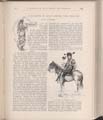
stnic.188407.001.01.jpg
A FOURTH OF JULY AMONG THE INDIANS.
—real Indians—real, live Indians—were what we, like all boys, wanted to see, and this was why, after leaving the railroad on which we had been traveling for several days and nights, we found ourselves at last in a big canvas-covered wagon, lumbering across the monotonous prairie.
We were on our way to see a celebration of the Fourth of July at a Dakota Indian Agency.
It was late in the afternoon of a hot summer's day. We had been riding since early morning, and had not met a living creature—not even a bird or snake. Only those who have experienced it know how wearying to the eyes it is to gaze all day long, and see nothing but the sky and grass.
However, an hour before sunset we did see something. At first, it looked like a mere speck against the sky; then it seemed like a bush or a shrub; but it rapidly increased in size as we approached. Then, with the aid of our field-glass, we saw it was a man on horseback. No, not exactly that either; it was an Indian chief riding an Indian pony. Now, I had seen Indians in the East—"Dime Museum Indians." I had seen the Indians who traveled with the circus—yes, and I had seen the untutored savages who sell bead-work at Niagara Falls; but this one was different—he was quite different. I felt sure that he was a genuine Indian. He was unlike the Indians I had seen East. The most striking thing was that this one presented a grand unwashed effect. It must have required years of patient industry in avoiding the wash-bowl, and great good luck in dodging the passing showers, for him to have acquired the rich effect of color which he displayed. Though it was one of July's hottest days, he had on his head an arrangement made of fur, with bead trimmings and four black-tipped feathers; a long braid of his hair, wound with strips of fur, hung down in the front of each ear, and strings of beads ornamented his neck. He wore a calico shirt, with tin bands on his arms above the elbow; a blanket was wrapped around his waist; his leggings had strips of beautiful bright bead-work, and his moccasins were ornamented in the same style. But in his right hand he was holding a most murderous-looking instrument. It was a long wooden club, into one end of which three sharp shining steel knife-blades were set. Though I had been complaining of the heat, still I now felt chilly as I looked at the weapon, and saw how well it matched the expression of his cruel mouth and piercing eyes.
He passed on while we were trying to make a sketch of him. However, the next day, an interpreter brought him around, and, for a small piece of tobacco, he was glad to pose while the sketch was being finished. We learned his name was "Can-h-des-ka-wan-ji-dan" (One Hoop).
A few moments later, we passed an iron post set firmly into the ground. It marked one of the[illustration - "ONE HOOP" IN HIS SUMMER COSTUME.] boundaries of the Indian Reservation. We were now on a tract of land set aside by the United States Government as the living-ground of sixteen hundred "Santee" Sioux Indians. We soon saw more Indians, who, like us, seemed to be moving toward the little village at the Indian Agency.

stnic.188407.001.02.jpg
Each group had put their belongings into a big bundle, and strapped it upon long poles, which were fastened at one end to the back of a pony. In this bundle, the little pappooses rode in [illustration - GOING TO THE AGENCY.] great comfort, looking like blackbirds peering from a nest. In some cases, an older child would be riding in great glee on the pony's back among the poles. The family baggage seemed about equally distributed between the pony and the squaw who led him. She was preceded by her rod and master, the noble red Indian, who carried no load except his long pipe.
The next thing of interest was what is called a Red River wagon. It was simply a cart with two large wheels, the whole vehicle made of wood. As the axles are never oiled, the Red River carry-all keeps up a most terrible squeaking. [illustration - A RED RIVER CARRY-ALL.] This charming music box was drawn by one ox, and contained an Indian, who was driving with a whip. His wife and children were seated on the bottom of this jolting and shrieking cart.
As we neared the Agency buildings, we passed many Indians who ad settled for the night. They chose the wooded ravines, near streams, by which to put up their tents, or "tepees," which consisted of long poles covered with patched and smoke-stained canvas, with two openings, one at the top for a "smoke-hole" and the other for a door, through which anyone must crawl to enter the domestic circle of the gentle savage. We entered several tepees, making ourselves welcome by gifts of tobacco to every member of the family. That night, after reaching the Agency and retiring to our beds, we dreamed of smoking great big pipes, with stems a mile long, which were passed to use by horrible-looking black witches. But morning came at last— and such a morning!
That Fourth of July morning I shall never forget. We were awakened by the most
blood-curdling yells that ever pierced the ears of three white boys. It was the
Indian war-whoop. I found myself instinctively feeling for my back hair, and
regretting the distance to the railroad. We lingered indoors in a rather
terrified condition, until we found out that this was simply the beginning of
the day's celebration. It was the "sham-fight"; but it looked real enough, when
the Indians came tearing by,
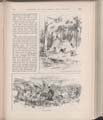
stnic.188407.001.03.jpg their ponies seeming to
enter into the excitement as throughly as their riders. There were some five
hundred, in full frills and war paint, and all giving those terrible yells.
Their costumes were simple, but gay in color—paint, feathers, and more paint, with an occasional shirt.
For weapons, they carried guns, rifles, and long spears. Bows and arrows seemed to be out of style. A few had round shields on their left arms.
Most of the tepees had been collected together and pitched so as to form a large
circle, and their wagons were placed outside this circle so as to make a sort of
protection for the defending party. The attacking party, brandishing their
weapons in the year with increased yells, rushed their excited and panting
ponies up the slope toward the tepees, where they were met with a rapid
discharge of blank cartridges and powder. Some of the ponies became frightened
and unmanageable, several riders were unhorsed, and general confusion prevailed.
The entrenched party, in the meantime, rushed out from behind their defenses,
climbing on top of their wagons, yelling and dancing around like demons. Added
to this, the sight of several riderless[illustration - AN INDIAN ENCAMPMENT FOR THE
NIGHT.]
[illustration - THE SHAM-FIGHT.]
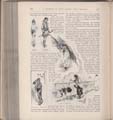
stnic.188407.001.04.jpgponies flying wildly from the tumult
made this sham-fight have a terribly realistic look.
After this excitement was over, the regular games which had been arranged for the day began.
In the foot-races, the costumes were so slight that there was nothing to describe—simply paint in fancy patterns, moccasins, and a girdle of red flannel. But how they could run! I did not supposed anything on two legs could go so fast. The la crosse costumes were bright and attractive. The leader of one side wore a shirt of soft, tanned buckskin, beadwork, and embroidery on the front, long fringe on the shoulders, bands around the arms, and deep fringe on the bottom of the skirt. The legs were bare to the knee, and from there down to the toes was one mass of fine [illustration - SHA-KE-TO-PA, A YOUNG BRAVE.] [illustration - SOUP AT WHOLESALE.] glittering bead-work. In the game, there were a hundred Indians engaged on each side. The game was long, but exciting, being skillfully played. The grounds extended about a mile in length. The ball was the size of a common base-ball, and felt almost solid as a rock, the center being of lead. The shape of the Indian la crosse stick is shown in the sketch.
Then came games on horseback. But the most interesting performance of the whole day, and one in which they manifested an absorbing interest, was—the dinner.
At 3 A. M. several oxen had been butchered, and from that time till the dinner
was served all the old squaws had their hands full. Fires were made in long
lines, poles placed over them, and high black pots, kettles, and zinc pails
filled with a combination of things, including beef and water, were suspended
there, and carefully tended by ancient Indian ladies in picturesque, witch-like
costumes, who gently stirred the boiling bouillon with pieces of wood, while
other seemingly more ancient and worn-out-looking squaws brought great bundles
of wood from the ravines, tied up in blankets and swung over their shoulders.
Think of a dinner for sixteen hundred noble chiefs and braves, stalwart
head-men, young bucks, old squaws, girls, and children! And such queer-looking
children—some dressed in full war costume, some in the most approved
dancing dresses. One little boy, whose name was Sha-ke-to-pa (Four Nails), had
five feathers—big ones, too—in his hair. His face was painted; he
wore great round ear-rings, and rows of beads and claws around his neck; bands
of beads on his little bare brown arms; embroidered
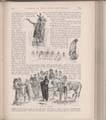
stnic.188407.001.05.jpg
leggings and beautiful moccasins, and a long piece of red cloth hanging from his
waist. In fact, he was [illustration - A WAITRESS.] as gaily dressed as a
grown-up Indian man, and he had a cunning little war-club, all ornamented and
painted. When the dinner was nearly ready ,the men began to seat themselves in a
long curved line. Behind them, the women and children were gathered. When
everything was ready, the chief, wearing a long arrangement of feathers hanging
from his back hair and several ebad pouches across his shoulders, with a long
staff in his left hand, walked into the center of the circle. Taking a spoonful
of the soup, he held it high in the air, and then, turning slowly around,
chanting a song, he poured the contents of the spoon upon the ground. This, an
interpreter explained to us, was done to appease the spirits of the air. After
this, the old squaws limped [illustration - AFTER THE PONY-RACE] nimbly around
with the pails of soup and other food, serving the men. After they were all
bountifully and repeatedly helped, the women and children, who had been
patiently waiting, were allowed to gather about the fragments and half-empty
pots and finish the repast, which they did with neatness and dispatch.
Then the warriors lay around and smoked their long-stem pipes, while the young men prepared for the pony races.
The first of these races was "open to all," and more than a hundred ponies and their riders were arranged in a row. Some of the ponies were very spirited, and seemed to fully realize what was going to take place, and they would persist in pushing ahead of the line. Then the other riders would start their ponies; then the whole line would have to be reformed. But finally, they were all started, and such shouting, and such waving of whips in the air!—and how the little ponies did jump! When the race was over, how we all crowded around the winner, and how proud the pony, as well as the rider, seemed to feel! Now we had a better chance to examine the ponies than ever before, and some were very handsome. And such prices! Think of buying a beautiful three-year-old cream-colored pony for twenty dollars!

stnic.188407.001.06.jpg
But as the hour of sunset approached, the interest int he races vanished, and so did most of the braves. They sought the seclusion of their bowers, to adorn themselves for the grand "grass dance," which was to begin at sunset.
What a contrast between their every-day dress and their dancing costumes! The former consists of a blanket more or less tattered or torn, while the gorgeousness of the latter discourages a description in words; so I refer you to the pictures. Of course, we were eager to purchase some of the Indian finery, but it was a bad time to trade successfully with the Indians. They were too much taken up with the pleasures of the day to care to turn an honest penny by parting with any of their ornaments. However, we succeeded in buying a big war-club set with knives, some pipes with carved stems a yard long, a few knife-sheaths and pouches glittering with beads, and several pairs of glittering moccasins,—most of which now adorn a New York studio.
Soon the highly decorated red men silently assembled inside a large space inclosed by bushes stuck into the ground. This was their dance-hall. The squaws were again shut out, as, according to Santee Sioux custom, they are not allowed to join in the dances with the men. The Indians, as they came in, sat quietly down around the sides of the inclosure. The musicians were [illustration - THE DANCE.] gathered around a big drum, on which they pounded with short sticks, while they sang a sort of wild, weird chant. The effect, to an uneducated white man's ear, was rather depressing, but it seemed very pleasing to the Indians.
[illustration - HOLIDAY CLOTHES AND EVERY-DAY CLOTHES.]The hall was opened by an old chief, who, rising slowly, beckoned the others to follow him. In his right hand the leader carried a wooden gun, ornamented with eagle's feathers; in the left hand he held a short stick, with bells attached to it. He wore a cap of otter skin, from which hung a long train. His face was carefully painted ins tripes of blue and yellow.
At first, they all moved slowly, jumping twice on each foot; then, as the
musicians struck up a more lively pounding and a more inspiring song, the
dancers moved with more rapidity, giving an occasional shout and waving their
arms in the air. As they grew warmer and more excited, the musicians redoubled
their exertions on the drum and changed their singing into prolonged howls; then
one of them, dropping his drum-sticks, sprang to his feet, and, waving his hands
over his head, he
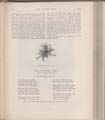
stnic.188407.001.07.jpg yelled till he was breathless,
urging on the dancers. This seemed to be the finishing touch. The orchestra and
dancers seemed to view with each other as to who should make a greater noise.
Their yells were deafening, and, brandishing their knives and tomahawks, they
sprang around with wonderful agility. Of course, the intense excitement could
last but a short time; the voices of the musicians began to fail, and, finally,
with one last grand effort, they all gave a terrible shout, and then there was
silence. The dancers crawled back to their places around the inclosure, and sank
exhausted to the grass. But soon some supple brave regained enough strength to
rise. The musicians slowly recommenced, other dancers came forward, and the "mad
dance" was again in full blast. And thus the revels went on, hour after hour,
all night, and continued even through the following day. But there was a curious
fascination about it, and, tired as we were after the long day, we stood there
looking on hour after hour. Finally, after midnight had passed, we gathered our
Indian purchases about us, including two beautiful ponies, and began our return
trip toward the railroad and civilization. But the monotonous sound of the
Indian drum followed us mile after mile over the prairie; in fact, it followed
us much better than my new spotted pony.
My arm aches now, as I remember how that pony hung back.

